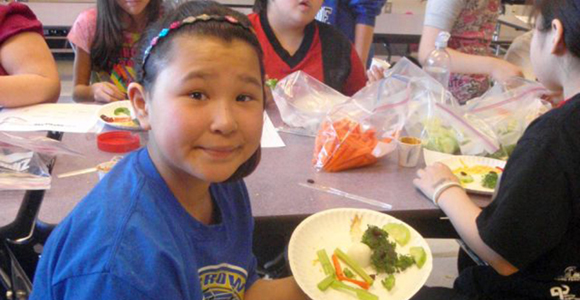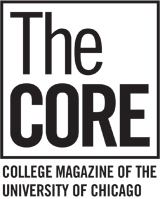
Beyond the Quads
Eat More Blubber
Nutritionist Jennifer Johnson, AB’87, dishes out counterintuitive advice.
Carrie Golus, AB’91, AM’93 | Photo courtesy of Jennifer Johnson
Eight hundred miles north of Anchorage, on the coast of the Chukchi Sea, lies Barrow, Alaska (population 4,200), the northernmost city in the United States. In the winter, when the sun sets for two months, the temperature routinely drops to 20° F below zero; in July, it sometimes gets as warm as 45° F.
Not surprisingly, there is little vegetation. There are also no roads to Barrow; it’s too difficult to build them on permafrost. So all groceries must be brought in by plane, and the prices are appropriately sky-high: a gallon of milk costs $10, cereal $9, carrots and bananas $3 a pound, potato chips $11 a bag.
Here Jennifer Johnson, AB’87, works as a nutritionist.
Despite the unreal food prices in Barrow, Johnson confronts the same problem as nutritionists in the lower 48: high rates of obesity, especially child obesity. In one study of Barrow and surrounding villages, half of the children were overweight or obese by kindergarten.
As the nutrition program manager for North Slope Borough, Johnson serves an 89,000-square-mile area (a little larger than Minnesota), counseling people—pregnant women, postpartum women with young children, and other high-risk clients—one on one. Her advice: consume less highly processed junk (of course) and eat more of Alaska’s traditional foods.
Johnson’s advice runs counter to that of generations of missionaries and teachers—and some contemporary health professionals—who have discouraged Alaskan natives from eating their traditional diet. True, foods such as herring eggs, caribou bone marrow, and muktuk (whale skin and blubber) are extremely fatty—but it’s healthy unsaturated fat. In fact, says Johnson, “the traditional diet, especially of the arctic people, is considered to be the most nutritious of any indigenous diet in the world.”
A vegetarian, Johnson has tried “walrus a few different ways, black muktuk from bowhead whale, white muktuk from beluga whale,” she says. “If someone has me over, I will eat whatever they offer me.” Her favorite traditional food is herring eggs, eaten by dipping them in hot water, then soy sauce: “They’re really good and crunchy.”
Johnson, who grew up in Chicago’s Ravenswood neighborhood, first fell in love with Alaska as a high school intern at the Field Museum. The museum had just renovated its Alaska exhibit, which included totem poles, blankets, and other artifacts collected by anthropologist Franz Boas at the turn of the century. (The collection includes examples of totem poles that have not been preserved in Alaska or anywhere else, Johnson notes; contemporary carvers travel to Chicago to study them.) She has difficulty explaining why she was so captivated: “Alaska just seemed very beautiful and very fascinating.”
Nonetheless, for college, Johnson traveled only 15 miles south to Hyde Park. After graduating with a biology degree in 1987, she worked for the eminent AIDS and cancer researcher Jerome Groopman at Harvard, doing HIV research. Still, she yearned for Alaska, where no comparable research was being done. So Johnson quit and returned to graduate school to study nutrition. “I knew I would be able to get a job right away,” Johnson says. “And I got a job right away, and I’ve been here ever since.” Her first position, which she took in 1996, was in relatively large and balmy Anchorage; she moved up to Barrow in 2010.
Johnson’s work is pleasantly varied. It includes research: she has published a number of papers about the nutritional value of traditional foods and how widely they are consumed. She redesigned the six-week cycle of menus at Barrow’s senior center to include more native dishes and less salty processed food. She’s working on an Inupiaq version of USDA’s MyPlate (a recent replacement for the Food Pyramid), so it will reflect local foods and language. She helped members of the local Brownie troop earn their snack badges; they made salads that looked like smiling faces.
Some semesters, Johnson teaches a course on nutrition at Ilisagvik College, Alaska’s only tribal college. She is often featured on local radio, talking about nutrition and other health topics, such as sleep. In the summer, when the sun lingers above the horizon, “people get out of the habit of going to bed or putting their kids to bed,” she says. “But kids need sleep to grow.” (Another guest on that program was the principal of Barrow High, who explained how difficult it is to educate sleepy students hopped up on energy drinks.)
Until very recently, people living in rural Alaska had no choice but to follow their traditional diets; there were few stores until after the Second World War. But today, as in the rest of the United States, the single largest source of calories is sugary beverages. It can be demoralizing to be a nutritionist, Johnson admits. “All these highly processed foods are engineered to be tasty to everybody,” she says. “And then we have to compete with the advertising. No one does a commercial for eating seal.”
